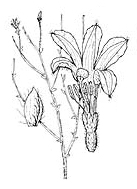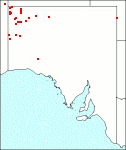Family: Goodeniaceae
Scaevola basedowii
Citation:
Carolin, Telopea 2:63 (1980).
Synonymy: Not Applicable Common name: None
Description:
Undershrub to 60 cm high; stems erect, divaricate-branched, robust, striated or ribbed, more or less hispidulous with glandular and non-glandular hairs; basal leaves few, narrow-elliptic, to 2.2 cm long, soon withering; cauline leaves sessile, remote, ovate or triangular to narrow-triangular, 2-8 mm long, 1-3 mm wide, acute to acuminate, hispidulous.
Flowers in a loose thyrse; bracts like upper leaves; peduncles 1.7-5.5 cm long, similar to stems; bracteoles ovate, 1-3 mm long, densely pubescent, opposite or subopposite near the apex of the peduncle; sepals triangular, 2-3.5 mm long, connate for half their length to form a campanulate calyx, glandular-pubescent; corolla 15-25 mm long, pale-mauve to white with brownish lines, pubescent outside, bearded inside the throat; lobes oblong-elliptic, 5-7 mm long, with entire wings; tube 10-15 mm long; style 10-13 mm long, pilose; indusium transversely oblong, c. 2 mm long, c. 3 mm wide, densely covered in whitish bristles c. 2.5 mm long with shorter white bristles around the orifice; ovary ellipsoid, 3-4 mm long, 2-celled, densely pubescent.
Fruit ellipsoid to globose, 5-7 mm long, tuberculate, pubescent, with a persistent calyx; mesocarp thin, dry.

| Habit, leaf, flower
|
Image source: fig. 635e in Jessop J.P. & Toelken H.R. (Ed.) 1986. Flora of South Australia (4th edn).
|
|
|
Distribution:
|
On red sand dunes and desert flats, often with Triodia and Allocasuarina decaisneana.
S.Aust.: NW. W.Aust.; N.T.
|
Conservation status:
native
Flowering time: at any time.
|

SA Distribution Map based
on current data relating to
specimens held in the
State Herbarium of South Australia
|
Biology:
No text
Taxonomic notes:
Distinguished from the related S. depauperata by the more pilose style, the more coarsely pubescent ovary, and usually by the vestiture of the stems, which varies greatly in density but always consists of minute glandular hairs and longer simple hairs.
Author:
Not yet available
|

